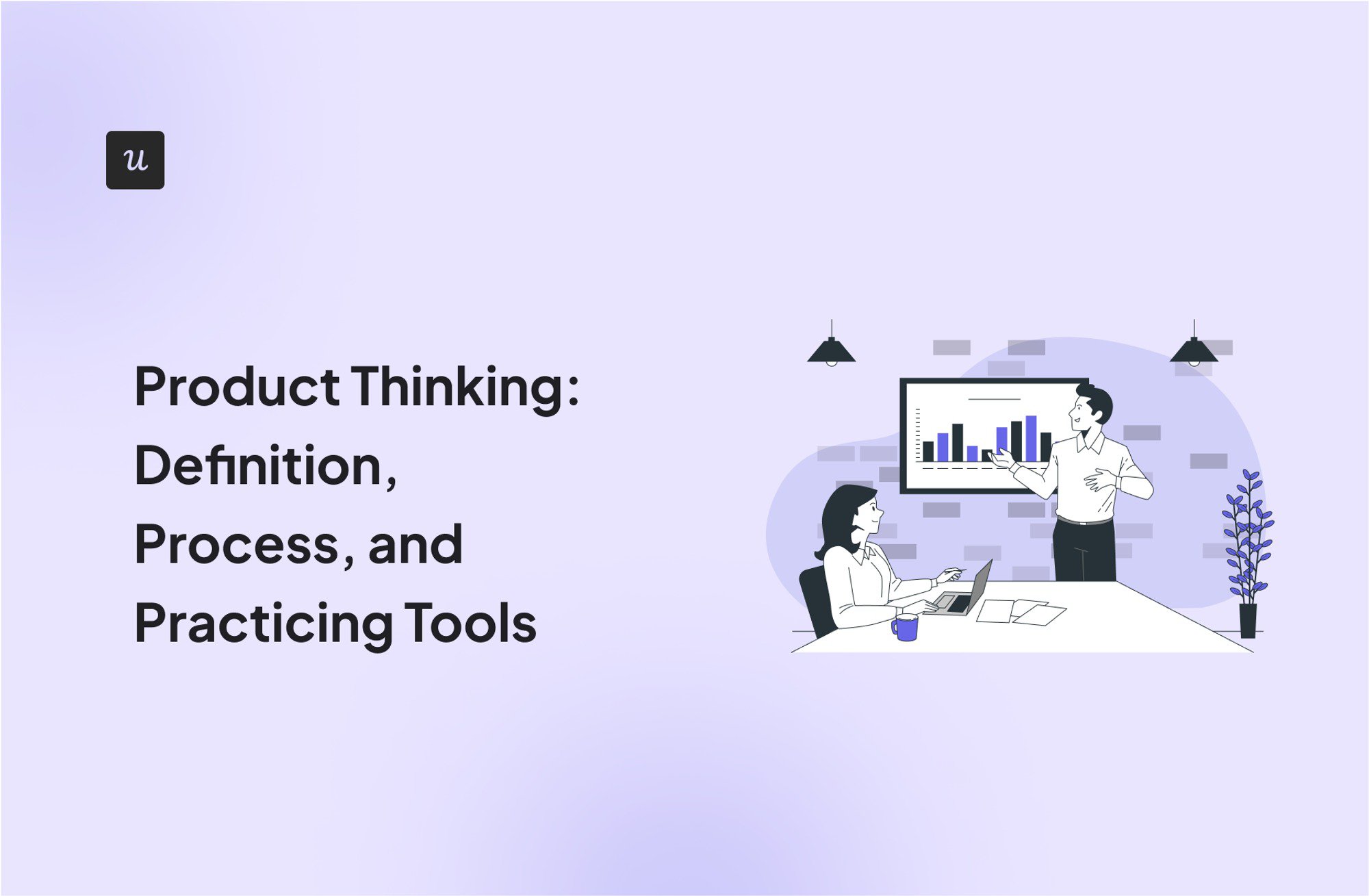
Get The Insights!
The fastest way to learn about Product Growth, Management & Trends.
What is product thinking?
Product thinking is the continuous process of identifying customer problems and finding solutions that make sense to them and the business. All, by having a strong understanding of your current technology limitations.
Why do product thinking skills matter?
Product thinking skills are important because they influence the product team’s decisions. Strong product thinking skills lead to:
- User-centric designs. When you adopt a product-thinking mindset, you can build experiences (UX) that serve user needs. This transforms product growth into product-led growth.
- Agile iteration and continuous discovery. For the user to have the last word, you need to test your product with real people, make changes based on their feedback, and test again. A product thinking approach supports (and understands) the need for multiple iterations.
- Scalability and sustainable product growth. Product thinking brings the user, the business, and the technology together. This means your developers also need to work alongside other departments. When teams work together and not in silos, you can better prepare for potential future scenarios.
- Continuous product learning. The more you test your existing solution, the more you get to know how your users interact with and what they value about your product. This form of continuous learning is a competitive advantage and can lead to sustained product-led growth.
What is the product thinking process?
Providing a good user experience will inevitably lead to higher retention, but you might not always have the money or software infrastructure to make user ideas come to life. This is why you need to establish an internal product thinking process.
Here’s what a product thinking process can look like:
- Define problems. Run user persona surveys or implement a jobs-to-be-done template to spot your current issues. Determine exactly what’s causing your users and your business to struggle, e.g., low conversion rates despite a large and steady organic traffic base.
- Identify opportunities. Then, measure the size of the opportunity, potential ROI, market opportunity, and possible market share gain. For instance, imagine your average order value (AOV) per customer is $70, and have a monthly traffic of 10,000 people. If you can take your conversion rate from 2% to 7%, you could increase your monthly income by $35,000.
- Correlate with business goals. Once you’ve calculated the opportunity size, determine how relevant this problem is to your business. Using the previous example, we can all agree the problem is critical to the business. Not knowing why customers aren’t converting could cause you to leave at least $35,000 on the table every month.
- Find a solution. Use solution space frameworks to present potential solutions and let the product managers and developers decide what to do based on your budget and current infrastructure. Build prototypes to test ideas and hypotheses and launch a beta version to collect more feedback. Keep iterating until you find the right solution.

How to leverage product thinking in product development?
When you make product thinking part of product development, you build more user-centric products. You can do this by following these six generic proven models:
1. Conduct user research to understand their needs
Product thinking is all about putting the user at the center. So, launch feedback surveys, conduct interviews or focus groups, do social listening, or build a voice of the customer map to define their needs.
The goal of user research is to define exactly what they need from a product like yours. You can also determine what day-to-day life needs your product can potentially solve.
Here’s an example of a user research survey that you can build using Userpilot:

2. Identify and assess market opportunities
As mentioned above, you must research market opportunities and correlate them with the benefits for your business. Running a product market fit analysis and conducting market research allow you to build products that solve user problems and make a profit.
The better you can identify gaps, trends, and areas of opportunity within your target market, the more tailored products you’ll be able to develop—and the more profit you’ll make.

3. Decide solutions and start building
Ideate and find problem solutions alongside your users. Conduct concept testing before settling on a solution. Once you find a problem solution fit, build an MVP with minimum viable features for users to interact with.
Test early and often so designers can get feedback they can build into the product. Continuous testing and editing of your product based on real user insights is one way to ensure your solution’s success.
4. Undertake strategic planning and allocation of resources
Your business resources are limited, use them efficiently. Achieve proper resource allocation through strategic planning and defining a product roadmap that outlines your product vision. Make sure this roadmap is linked to bigger business goals.
For example, if your designers are working on a new feature, take that into account before assigning them more work. Proper resource allocation leads to better results and a more stable business.
5. Collect data for analytics
Test your product before, during, and after development to collect user behavioral and sentiment data. You can use a tool like Userpilot to collect event-tracking data, user behavior tracking, and survey analytics of in-app interventions. Analyze the results and make plans to iterate on the same product idea until you get favorable results.

6. Continuously iterate your product based on findings
Lastly, and throughout the product lifecycle, iterate on your product based on an analysis of user feedback.
The faster you can act upon user feedback and improve your product, the closer you get to increased customer satisfaction.
For example, using NPS response tags in Userpilot, you can quickly identify common issues among your NPS detractors and set guidelines to build better products.

Problem space tools to practice product thinking mindset
Here are problem space tools to dive deep into your business and users’ problems and make product thinking come to life:
1. The 5W1H approach to identify the underlying problems
This tool invites you to ask questions that dig into your tangible issues to identify the real or hidden problems.
Imagine your problem is that you’re the CEO of a content marketing agency with a low client retention rate using this tool.
- What is the problem? The agency has a great sales team, so it’s easy to close deals, but the client-facing team is disorganized and late.
- Who is experiencing the problem? Clients. They’re not feeling satisfied with the service, so they churn fast.
- Where does the problem happen? At the editing stage. Editors are scheduled to edit the pieces after the client meeting. The work is usually late.
- Why is this problem happening? Because the project managers have too many responsibilities.
- When does the problem usually occur? At the end of the three-month mark.
- How to approach this problem? Hire more project managers or allow writers and editors to set deadlines for themselves.

2. The Mom Test to collect insights
The Mom Test is a problem space tool for having conversations and asking questions to gain genuine user insights.
Ask questions about past behaviors, specific cases, concrete details, unbiased questions, general user behavior, and recent experience. For example:
- What motivated you to start using [product/service]?
- What goals or objectives are you trying to achieve by using [product/service]?
- Can you tell me about the last time you [performed X action]?
- How many apps do you use daily to achieve [X goal]?

3. The jobs-to-be-done framework to determine user needs
The JTBD framework proposes that people are willing to purchase a license or a product if it allows them to complete a certain job.
JTBD in product management implies that users can view jobs as activities or as progress, i.e., your product/service can help them perform certain tasks or improve their lives.
To identify the problem space using this framework, you can conduct micro surveys or interviews. Analyze the answers, create a job map, and determine which jobs you’ll address with your product.

Source: Figma.
Solution space tools to practice product thinking
After you’ve identified the problem, it’s time to think of ways to solve it. These solution space tools propose different problem-solving techniques that place the user at the center.
1. Create user stories
User stories are a powerful way of identifying and communicating customer needs and requirements. The idea is to write a paragraph that tells a story about who the user is and what they want. The product team is the one to determine how to solve the problem based on other testing methods.
Every user story should contain three elements: Persona, action, and outcome.
For example, as a project manager, I want to be able to assign deadlines to tasks in bulk so that I can reduce mistakes and use my time in strategic allocation planning.

Source: Justinmind.
2. Leverage problem-solving methods
This solution space tool invites you to think of different ways to solve a problem based on your several existing solutions. For example:
- Minimize your offer by reducing the scope, e.g., YouTube vs. Coursera.
- Maximize your product by adding more functionality to an existing solution, e.g., your phone’s note app vs. Notion.
- Transform your tool by offering multiple separate solutions, e.g., Uber and Uber Eats.
- Combine two or more existing solutions into one, e.g., WhatsApp (messaging, calling, video calling). This is only recommended for products getting to advanced growth stages instead of first-release ones.
- Modify or rearrange your tool by revamping and improving a current product, e.g., your phone reminders into Doist.
- Substitute one part of a current solution, e.g., Readers (you could do this from your phone or laptop).

Source: Naren Katam.
3. Use value proposition canvas
A value proposition canvas is a tool for positioning a product/service around the customer’s values and needs.
The canvas is usually divided into two parts: the customer profile and the value map.
The customer profile includes the different jobs they want to address and their pains and gains. The value map, on the other hand, focuses on how the business can create value for the customer.

Conclusion
Embracing product thinking leads to better product management and more satisfied users. Do this by implementing and following the product thinking process.
You can also use problem and solution space tools to identify the root cause of your users’ struggles and ideate creative ways to solve them.
If you want to leverage product-led growth, try Userpilot. Here, you’ll be able to conduct user research, add in-app interventions, and keep track of your user feedback, all in one place. Get a demo.





![10 Upsell Email Examples That Drive Conversions [+ Best Practices to Learn from Them] cover](https://blog-static.userpilot.com/blog/wp-content/uploads/2025/07/10-upsell-email-examples-that-drive-conversions-best-practices-you-can-learn-from-them_3f04b94940147631fa7cb7df795caedc_2000-1024x670.png)